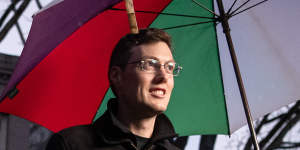He knew of public charging stations at nearby shopping centres and business parks,but this felt too hard,and the couple bought a hybrid instead.

Eddy Blaxell does not have off-street parking at his rented home in Newtown and bought an electric vehicle only once a public charger was installed nearby.Wolter Peeters
In March,the family was finally able to upgrade to a second-hand electric car after an EV charger was installed on a power pole near their home.
“Mentally,it became a lot easier to imagine us owning[an electric] car when we knew we could charge it on the street around the corner from home,” Blaxell said.
Public EV infrastructure,including kerbside chargers,is pivotal to the growth of the EV market,especially in dense city areas of Sydney and Melbourne where people do not have off-street parking.
The charger near Blaxell’s home in Newtown is part of a City of Sydney trial. Ausgrid,which owns the power pole,partnered with EVX,an EV charging specialist,to install,maintain and operate the pole.
The ringfencing rules in the national electricity market mean that electricity distributors – the companies that own the poles and wires and have a monopoly in a certain geographic area – are not permitted to directly install and operate chargers but to do it only in partnership.
All three NSW distributors – Ausgrid,Endeavour Energy and Essential Energy – confirmed they wanted a bigger role in EV infrastructure and were lobbying to remove the restrictions.
However,in Victoria,a CitiPower and Powercor spokesman said the company was working to connect EV chargers across the state including in inner-city Melbourne,but it planned to continue working with third-party providers.
Rob Amphlett Lewis,group executive of distributed services at Ausgrid,said he was in discussions with the Australian Energy Regulator and the NSW government about changing the rules because he believed the company could do it more efficiently and cheaply on its own.
The NSW government has set a goal for 52 per cent of all new car sales by 2030-2031 to be electric vehicles. Amphlett Lewis said there were only 150 kerbside chargers within its territory,which covers most of Sydney,the Central Coast,Newcastle and the Hunter. The company estimates the state would need 30,000 public chargers to meet demand and 11,000 kerbside chargers within the Ausgrid boundaries alone.
Amphlett Lewis said most people did not want to pay exorbitant rates for fast chargers and failure to meet community needs would mean more people finding makeshift solutions such as “hanging their cable over a tree or laying across the curb” to plug in from home. He said government funding would be needed to ensure kerbside charging was no more expensive than at home.
“We wouldn’t be selling the electricity,we’d be doing exactly what we do with your home and that is providing access to the electricity for a retailer to provide the service,” he said.
Amphlett Lewis said vehicle-to-grid charging – where the EV owner sells electricity back to the grid – could eventuate down the track.
Smart Energy Council acting chief executive Richie Merzian said the solution was not to increase the power of the networks,which had been slow to invest in this space,but to properly open up the market.
“The networks have been trying to break down the ringfencing for some time in other areas like batteries,” Merzian said. “This comes at the expense of fair competition and making the best use of household energy resources like solar,batteries and heat pumps.
“There are hundreds of companies that want to partner with the networks to fast-track EV charging.”
Merzian said Norway,where four out of five new cars are EVs,had a model of affordable charging stations at service stations rather than small kerbside chargers.
Rewiring Australia executive director Dan Cass said:“We need chargers everywhere in communities,but this does not mean handing them over to highly profitable distribution networks to strengthen their monopoly position.”
Grattan Institute’s energy expert Tony Wood said he was concerned that all electricity users would pay for the infrastructure rather than just EV owners and this would be “a cross-subsidy from poor to rich”.
In May,the NSW government announced it was spending $4.1 million in grants to local governments in Sydney and Newcastle,and directly to EV charging companies to fund 671 EV charging ports at 391 sites.
NSW Minister for Climate Change and Energy Penny Sharpe said almost 30 per cent of NSW drivers did not have access to private,off-street parking to charge an EV and this was higher in metro areas.
Blaxell says his EV drives 300 kilometres on one charge and he needs to recharge every three weeks. The electricity is more expensive than at home – even though,as a renter,he does not have solar panels – but it was 25 per cent cheaper than the fuel bill for the hybrid and about half the cost of a petrol car.
He does not care who owns the charger. “What matters is that it works and it’s easy to use,” he said.
Start the day with a summary of the day’s most important and interesting stories,analysis and insights..